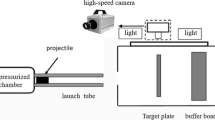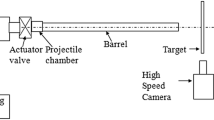Abstract
A multi-layer fabric coated aluminum plate is usually used in the hard upper torso of space suit to protect astronauts from getting hurt by space dust. In this paper, the protective performance of the multi-layer fabric coated aluminum plate is investigated. To establish its ballistic limit equation, thirteen hyper velocity impact tests with different impact velocities (maximum velocity is 6.19 km/s) and projectile diameters have been conducted. To provide data for impact velocity higher than 6.2 km/s which is hard to be obtained by tests due to the limitations of test equipment capacity, a material point method (MPM) model is established for the multi-layer fabric coated aluminum plate and validated/corrected using the test results. The numerical results obtained using the corrected MPM model for impact velocity higher than 6.2 km/s are used together with the test results to develop the ballistic limit equation. The corrected MPM model and the ballistic limit equation developed for the multi-layer fabric coated aluminum plate provide an effective tool for the space suit design.





















Similar content being viewed by others

References
Bintao, L.: Research and application for special material models of spacecraft shielding structure. In PhD Thesis (2011)
Bohannan, A., Fahrenthold, E.: Hypervelocity impact simulation using membrane particle-elements. Int. J. Impact Eng. 35(12), 1497–1502 (2008)
Chen, Z.P., Qiu, X.M., Zhang, X., Lian, Y.P.: Improved coupling of finite element method with material point method based on a particle-to-surface contact algorithm. Comput. Methods Appl. Mech. Eng. 293(15), 1–19 (2015)
Christiansen, E.L., Crews, J.L., Kerr, J.H., Chhabildas, L.C.: Hypervelocity impact testing above 10 km/s of advanced orbital debris shields. AIP Conf. Proc. 370, 1183–1186 (1996)
Christiansen, E.L., Cour-Palais, B.G., Friesen, L.J.: Extravehicular activity suit penetration resistance. Int. J. Impact Eng. 23(1), 113–124 (1999)
Gleghorn G., Asay, J., Atkinson, D., Flury, W., Johnson, N., Kessler, D., Knowles, S., Rex, D., Toda, S., Veniaminov, S.: Orbital debris: a technical assessment. In Nasa Sti/recon Technical Report N 95 (1969)
Gong, W.W., Liu, Y., Zhang, X., Ma, H.L.: Numerical investigation on dynamical response of aluminum foam subject to hypervelocity impact with material point method. CMES. Comput. Model. Eng. Sci. 83(5), 527–545 (2012)
Hayhurst, C., Livingstone, I.: Advanced numerical simulations for hypervelocity impacts: AUTODYN simulations. Report R098, Century Dynamics Ltd. (1998)
Hosur, M.V., Vaidya, U.K., Ulven, C., Jeelani, S.: Performance of stitched/unstitched woven carbon/epoxy composites under high velocity impact loading. Compos. Struct. 64(3), 455–466 (2004)
Hua, C.: Research on the mechanical and chemical properties of polyimide and its influence on hypervelocity impact phenomena. In PhD Thesis (2013)
Huang, P., Zhang, X., Ma, S.: Shared memory OpenMP parallelization of explicit mpm and its application to hypervelocity impact. CMES-Comput. Model. Eng. Sci. 38, 119–147 (2008)
Huang, P., Zhang, X., Ma, S., Huang, X.: Contact algorithms for the material point method in impact and penetration simulation. Int. J. Numer. Methods Eng. 85(4), 498–517 (2011)
Johnson, G.R., Cook, W.H.: A constitutive model and data for metals subjected to large strains, high strain rates, and high temperatures. In: Proceedings of the 7th International Symposium on Ballistics, pp. 541–547. (1983)
Johnson, G.R., Holmquist, T.J.: Evaluation of cylinder-impact test data for constitutive model constants. J. Appl. Phys. 64(8), 3901–3910 (1988)
Lian, Y.P., Zhang, X., Zhou, X., Ma, S., Zhao, Y.L.: Numerical simulation of explosively driven metal by material point method. Int. J. Impact Eng. 38, 237–245 (2011a)
Lian, Y.P., Zhang, X., Zhou, X., Ma, Z.T.: A FEMP method and its application in modeling dynamic response of reinforced concrete subjected to impact loading. Comput. Methods Appl. Mech. Eng. 200(17–20), 1659–1670 (2011b)
Lian, Y.P., Zhang, X., Liu, Y.: An adaptive finite element material point method and its application in extreme deformation problems. Comput. Methods Appl. Mech. Eng. 241–244(1), 275–285 (2012)
Lian, Y.P., Liu, Y., Zhang, X.: Coupling of membrane element with material point method for fluid-membrane interaction problems. Int. J. Mech. Mater. Des. 10(2), 199–211 (2014a)
Lian, Y.P., Zhang, X., Zhang, F., Cui, X.X.: Tied interface grid material point method for problems with localized extreme deformation. Int. J. Impact Eng. 70, 50–61 (2014b)
Lian, Y., Yang, P., Zhang, X., Zhang, F., Liu, Y., Huang, P.: A mesh-grading material point method and its parallelization for problems with localized extreme deformation. Comput. Methods Appl. Mech. Eng. 289, 291–315 (2015)
Liu, P., Liu, Y., Zhang, X.: Improved shielding structure with double honeycomb cores for hyper-velocity impact. Mech. Res. Commun. 69, 34–39 (2015a)
Liu, P., Liu, Y., Zhang, X.: Internal-structure-model based simulation research of shielding properties of honeycomb sandwich panel subjected to high-velocity impact. Int. J. Impact Eng. 77, 120–133 (2015b)
Liu, P., Liu, Y., Zhang, X.: Simulation of hyper-velocity impact on double honeycomb sandwich panel and its staggered improvement with internal-structure model. Int. J. Mech. Mater. Des. 12(2), 241–254 (2016)
Liu, S., Huang, J., Li, Y., Zhou, Z., Ma, Z., Lan, S., Chen, H., Chen, P.: Recent advancement of hypervelocity impact tests at hai, CARDC. Manned Spacefl. 6, 17–23 (2011)
Liu, Y., Wang, H.K., Zhang, X.: A multiscale framework for high-velocity impact process with combined material point method and molecular dynamics. Int. J. Mech. Mater. Des. 9(2), 127–139 (2013)
Ma, S., Zhang, X., Lian, Y.P., Zhou, X.: Simulation of high explosive explosion using adaptive material point method. CMES-Comput. Model. Eng. Sci. 39(2), 101–123 (2009a)
Ma, S., Zhang, X., Qiu, X.M.: Comparison study of mpm and sph in modeling hypervelocity impact problems. Int. J. Impact Eng. 36(2), 272–282 (2009b)
Ma, Z., Zhang, X., Huang, P.: An object-oriented MPM framework for simulation of large deformation and contact of numerous grains. CMES-Comput. Model. Eng. Sci. 55(1), 61–87 (2010)
Mcallum, W.E.: Development of meteoroid protection for extravehicular-activity space suits. J. Spacecr. Rockets. 6(11), 1225–1228 (1969)
Sulsky, D., Chen, Z., Schreyer, H.L.: A particle method for history-dependent materials. Comput. Methods Appl. Mech. Eng. 118(1–2), 179–196 (1994)
Sulsky, D., Zhou, S.J., Schreyer, H.L.: Application of a particle-in-cell method to solid mechanics. Comput. Phys. Commun. 87(1–2), 236–252 (1995)
White, D.M., Wicklein, M., Clegg, R.A., Nahme, H.: Multi-layer insulation material models suitable for hypervelocity impact simulations. Int. J. Impact Eng. 35(12), 1853–1860 (2008)
Zhang, J.: Research of the mc nylon composite material stuffed with pulverized fuel ash. In PhD thesis, Nanjing University of Science and Technology (2004)
Zhang, X., Sze, K.Y., Ma, S.: An explicit material point finite element method for hyper velocity impact. Int. J. Numer. Methods Eng. 66, 689–706 (2006)
Zhang, X., Chen, Z., Liu, Y.: The Material Point Method-A Continuum-Based Particle Method for Extreme Loading Cases. Academic Press, Cambridge (2016)
Zhang, F., Zhang, X., Liu, Y.: An augmented incompressible material point method for modeling liquid sloshing problems. Int. J. Mech. Mater. Des. 1–15, (2017). doi:10.1007/s10999-017-9366-5
Zukas, J.A.: Introduction to Hydrocodes. Elsevier, Amsterdam (2004)
Acknowledgements
This work was supported by the National Natural Science Foundation of China (Grant No. 11672154) and Science Challenge Project (TZ2017002).
Author information
Authors and Affiliations
Corresponding author
Rights and permissions
About this article
Cite this article
Ye, Z., Zhang, X., Zheng, G. et al. A material point method model and ballistic limit equation for hyper velocity impact of multi-layer fabric coated aluminum plate. Int J Mech Mater Des 14, 511–526 (2018). https://doi.org/10.1007/s10999-017-9387-0
Received:
Accepted:
Published:
Issue Date:
DOI: https://doi.org/10.1007/s10999-017-9387-0



